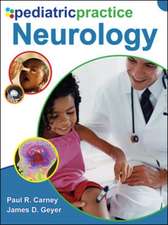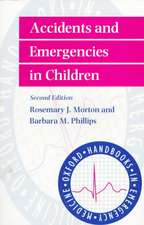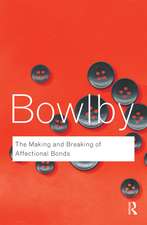Pediatric and Adolescent Concussion: Diagnosis, Management, and Outcomes
Editat de Jennifer Niskala Apps, Kevin D. Walteren Limba Engleză Paperback – 3 mar 2014
| Toate formatele și edițiile | Preț | Express |
|---|---|---|
| Paperback (1) | 365.25 lei 6-8 săpt. | |
| Springer – 3 mar 2014 | 365.25 lei 6-8 săpt. | |
| Hardback (1) | 392.60 lei 6-8 săpt. | |
| Springer – 14 dec 2011 | 392.60 lei 6-8 săpt. |
Preț: 365.25 lei
Preț vechi: 384.48 lei
-5% Nou
69.91€ • 75.97$ • 58.76£
Carte tipărită la comandă
Livrare economică 21 aprilie-05 mai
Specificații
ISBN-10: 1493901699
Pagini: 232
Ilustrații: XVI, 216 p.
Dimensiuni: 155 x 235 x 12 mm
Greutate: 0.33 kg
Ediția:2012
Editura: Springer
Colecția Springer
Locul publicării:New York, NY, United States
Public țintă
Professional/practitionerRecenzii
“Volume brings together many of the issues relevant to the field of concussion management … . The wide range of perspectives allows for the book to be used by students and clinicians … with each chapter as a stand-alone. … For the practicing neuropsychologist new to concussion management, this text will be a useful reference as the reviews presented within each of the chapters are timely with each chapter ending with bulleted key points, making it an easy to reference text … .” (Jennifer Reesman, Archives of Clinical Neuropsychology, October, 2012)
Notă biografică
Textul de pe ultima copertă
Caracteristici
Descriere
Among information available for individuals interested in concussions in children are several comprehensive books reviewing mild traumatic brain injury (TBI), post-concussion syndrome (PCS), and even sports-related concussions. Volumes also exist addressing the broad range of mild to severe TBI in children with most attention in the moderate to severe range. However, for individuals with specific questions about the status of concussions as a form of mild TBI in the pediatric population, the information is fragmented. Oftentimes, chapters must be selected from larger works, information ascertained from an exhaustive review of research literature, or even pieced together from massive amounts of information available on the internet. This book offers the first centralized, comprehensive resource about concussions in the pediatric population. By providing the most up-to-date review of the practical aspects of these injuries in children, it will serve as a resource for not only practitioners and clinicians but also families, teachers, and therapists working with children.
This book will provide a review of the status of the current literature and research in assessing, diagnosing, and clinically managing pediatric concussions. Controversies in these areas will be reviewed in detail. Further, ethical issues surrounding the identification and management of these injuries will also be a focus. By providing authoritative coverage of the research in children, readers will be guided through translating research into the current state of practice.
By breaking this book into sections, the information will flow logically, providing a manageable format for readers to access. Each section will consist of clearly identified chapters, each addressing a salient aspect of the current research. Each chapter, ranging from 20 to 30 pages in manuscript length, will utilize tables and figures as needed, provide useful guides and tools when available, and conclude with summary statements highlighting the prominent findings. Additionally, individual chapters will contain references, making accessing additional resources convenient for the reader. References will also be accumulated in an appendix at the end of the book.
The first section will review the history of concussions, providing a background of the development of the current state of knowledge. In addition, basic terminology will be reviewed. In the second section, the causes of concussions in children will be reviewed. This will include a scientific review of the current state of research theoretically explaining the potential causes of concussions. Section three will review the assessment of symptoms of concussion. This will include assessment and symptom expression throughout time following an injury, as well as the most recent information on the use of various technological approaches. The fourth and final section will focus on treatment and recovery of children with concussions. This will include discussions of all aspects of a child’s life impacted by these injuries within a developmental context unique to children. Additionally, ethical considerations will be given particular focus in the context of working with adults in the child’s life and injury considerations across environments. Finally, consolidation the current status of research into the most recent thoughts on prevention of concussions will be reviewed. Table of Contents follows.








